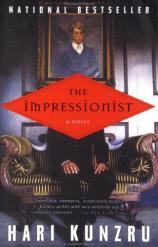Reading Group Guide
Discussion Questions
The Impressionist

1. The pale splendor of Pran Nath's skin was proof, in his aunts' opinion, of the family's distinguished bloodline. But later, his milky complexion became a telltale trait of his tainted heritage. Discuss the benefits and drawbacks of this chameleon-like characteristic.
2. Anjali chooses to reveal the truth of Pran Nath's ancestry at a point of utter conflict, blaming the young master's blended blood for the epidemic that had shadowed the city of Agra. Explain the magnitude of this implication for Amar Nath Razdan.
3. Does the protagonist choose to adopt each new guise, or do pressures of the political or social climate force him to find a new persona? When does he exhibit free will in his decision to change?
4. Anjali's indictment of Pran Nath states how his presence in the household breaks the tenets of the orthodox Hindu religion and suggests that it has brought a curse on them all. What other symbols led Anjali to be wary of Pran Nath and his mother? What other cabalistic methods do characters employ to interpret life?
5. In every manifestation, the title character must face caste systems and social hierarchies. Discuss the various make-up of the societies and the working of their social construct. Does he ever penetrate one of these sects or is he perpetually an outsider?
6. Discuss the concept of pure blood versus mixed. How did the British imperialistic campaign, the Great War for Civilisation, contribute to the extreme opinions regarding race and culture? What parallels can be drawn between the climate in colonial India and Africa and other significant social conflicts?
7. The tiger hunt exposed countless political and personal motivations. How was the Nawab's party attempting to indulge the visiting British faction? What other schemes were devised to earn the loyalty of the English?
8. The duplicity of the Impressionist's skin could not create alternate identities on its own. Discuss the various attire worn by the Impressionist in his many incarnations. From schoolboy uniforms and silk saris to academic robes and adventurer's khakis, how did his clothing shape others' impressions?
9. What motivation is the strongest for the Impressionist on his journey? What is his ultimate goal? Does his objective change as the book progresses, or is there an enduring, instinctual drive that maintains him?
10. After Robert is taken in by Mrs. Macfarlane, he does not submit to a focused life as a dutiful foster child. What factors contributed to his double life in Bombay? How might the severed Macfarlane household have perpetuated his bewildered sense of self?
11. After assuming the role of Jonathan Bridgeman, the main character had only one fearful brush with exposure. How does he deal with his meeting with Aunt Berthilda? What conclusions regarding perception can be drawn from the Headmaster's and Mr. Spavin's reactions to the event?
12. How was Star's dalliance with Sweets comparable to Jonathan's pursuit of Star? Was Star attracted to Sweet's humanity, or his blackness? Was Star's reaction when Sweets arrived at the club genuine? Were her intentions with Jonathan honorable?
13. When he is dispelled from his home, Pran considers himself entirely Indian. At what point, and under what influences, does he begin to recognize his English heritage. Why does he not strive harder to reestablish himself as an Indian?
14. Why was the Impressionist spared by the Fotse? What was the significance of the ceremony conducted in the cave? What is the Impressionist's fear if the old man draws the European spirit out?
15. In the end, what connections can be drawn between the Impressionist and his biological parents? What has he inherited from them?
16. In his fifteen years as the only son of a wealthy academic of high caste, Pran Nath could do no wrong in his family's opinion, yet his arrogance, unappealing practical jokes, and disrespectful nature alienated the servants and townspeople. Was his attitude a reflection of his upbringing? Or was it a sign of bad blood? Did his childhood misdeeds foreshadow his later transgressions?
17. As he starts to make his way through his succession of personalities, the Impressionist also begins a pattern of betrayal. Who does he deceive the most? Who stands to be hurt the most by him? And whom does he most regret misleading? Why?
18. The visit of Sir Wyndham Braddock to Fatehpur emphasizes the cultural distinctions between the military representative of the Crown and their colonial constituents. Discuss the stagings of Sir Wyndham's ceremonial procession to the palace and the afternoon tea party at Gus and Charlie Privett-Clampe's residence and the incongruities these events unveil.
19. Compare the lifestyles and interests of the Nawab, the Sublime Ruler, and Prince Firoz. How do these two brothers illustrate the struggle between traditional Indian culture and the western influence?
20. Discuss the character of Reverend Macfarlane. What do his allegiance to the missionary lifestyle, his relationship with his wife, his opinion of the Bombay population, and his devotion to his anthropological research convey about his personal conflicts?
21. What was Bobby's intention when he decided to accompany the original Jonathan Bridgeman on his search for a tart? What might he have anticipated from the evening's events?
22. In adopting new identities, can one's innate sense of morality change? What kind of person is the Impressionist? Are his decisions immoral, unlawful? How would his actions be viewed in different societies, according to different ethical codes?
23. Why is Jonathan so lonely after Paul Gertler's forced departure? What made Paul an exception? Why was he worthy of Jonathan's friendship?
24. Why did Jonathan gravitate to Astarte Chapel? Did his attraction go beyond her English Rose appeal? Why did Star find Jonathan's quintessentially British façade boring, almost offensive?
25. Pran's beauty is noted in his initial description. Heralded in his family as physical evidence of their fine Kashmiri bloodlines, his beauty is his only charm. How would Pran's story be different, in all its stages, if he were not as definitively attractive?
26. Professor Chapel found a very different tribe when he returned to Fotseland for the final time. Discuss the tribe's evolution and the instigating factors. Why might the Fotse have named the English "sorcerors?"
27. When Jonathan returns from recording information for the census, the other members of the exhibition accuse him of not being "a joiner." While this statement is true, it is also ironic. Discuss the emotional state of the group and how their reaction affects Jonathan.
28. Can anyone be himself while attempting to like everyone else? In an attempt to fit in, did Jonathan take conventionality too far and lose individuality altogether?
29. How would the main character's fate be different if the story were to take place in the twenty-first century?
30. There are specific moments in which the main character is seized by fear, a panic of identity. Did the man who was once Pran Nath strip himself of his own persona? Can an individual erase his or her soul?
The Impressionist
- Publication Date: March 25, 2003
- Genres: Fiction
- Paperback: 480 pages
- Publisher: Plume
- ISBN-10: 0452283973
- ISBN-13: 9780452283978







